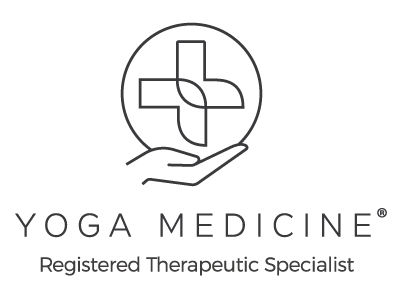Yoga Therapeutics as Personalized Medicine
- Joy Zazzera

- Feb 16
- 4 min read
Updated: 4 days ago
Yoga therapeutics offers a personalized, evidence-informed approach that differs from traditional yoga by meeting your body where it is—supporting healing, resilience, and real-life challenges.
When most people think of yoga, they picture group classes, set sequences, and maybe even performance-like poses. While this type of yoga can be supportive and beneficial, it isn’t always accessible or adaptable—especially if you’re recovering from surgery, living with a joint replacement, working with a changed body, or experiencing reduced mobility, chronic stress or exhaustion.
Yoga therapeutics, as defined by Yoga Medicine®, is different. It’s not a new kind of yoga—it’s a personalized, evidence-informed approach to yoga that supports healing, resilience, and sustainable well-being. It draws from both ancient yogic wisdom and modern medical science, integrating functional movement, anatomy, and biomechanics with breath work, mindfulness and meditation, and relearning the art of rest. Yoga Medicine® Therapeutic Specialists have completed comprehensive academic training in anatomy, movement science, orthopedics, and yoga research, possessing expertise that magnify the therapeutic effects of yoga in order to create personalized programs for individuals at any level.

The goal of yoga therapeutics is to meet you exactly where you are—not just addressing symptoms or physical limitations, but supporting your whole system: body, breath, mind, and lifestyle. It offers a compassionate and strategic way to help you move, live, and heal more effectively.
Here’s how general yoga and yoga therapeutics compare:
General Yoga
Group classes with set sequences
May emphasize performance or advanced poses
Focused on general fitness or stress relief
Assumes baseline mobility/ability
Teachers may have 200-500 hours of training in teacher-training programs with a wide variability of program quality and teacher-readiness upon graduation
Yoga Therapeutics
Individualized or small group practices tailored to your health issues
Emphasizes function, safety, sustainability, and problem-solving approaches
Meets you exactly where you are - regardless of age, conditions or ability
Yoga Medicine Therapeutic Specialists have 500-1000+ hours of advanced, medically-informed training and completion of client case studies over defined periods of care
Yoga is more than poses. It’s a toolkit for physical, emotional, and nervous system well-being. It includes modalities that support the whole — mindful movement, myofascial release, breath work, meditation, and restorative rest—each of which can be adapted to meet your unique needs.
Yoga therapeutics applies these tools intentionally and individually. It’s informed by clinical research, functional anatomy, and ancient teachings, and designed to support real-life bodies—not just what we do on the mat, but how we live and feel off the mat as well.
Integrated yoga acknowledges the interplay between body, breath, mind, and behavior. It blends personal agency, regulation, and reflection. When we practice yoga therapeutics, we’re integrating all parts of ourselves into a meaningful, healing process.

Perhaps you’ve come across my name because I offer a different message about yoga—one that resonates with your needs right now, even if you're still figuring out what those needs are. That’s my profession: to guide you toward greater understanding, function, and resilience. I’ve heard my work described as “yoga for misfits” or “easy yoga.” I take that as a compliment. It confirms the path I’ve chosen—offering yoga as a form of personalized medicine for those who are often overlooked or underserved.
At Yoga with Joy, I teach from this integrated, therapeutic lens. I offer evidence-informed tools that you can apply in your daily life—training your attention, your breath, your confidence, and your capacity to adapt. Because real healing isn’t about pushing harder. It’s about listening more deeply.
We must remember that we have an incredible capacity to self-regulate—not only how we feel, but how we move, breathe, and think. In times of stress or uncertainty, we can return to healthy routines that support stamina, calm, and resilience. How we feel emotionally matters just as much as how we move physically. Movement and emotion are connected. When the body feels safe, the mind often follows. This is the essence of yoga therapeutics. And this doesn’t require advanced practice. What matters is the regular inclusion of just enough yoga therapeutics to make your quality of life better—a little and often approach, right now.
In a culture that values doing more and pushing through, the idea of rest often feels radical. But in yoga therapeutics, rest is not a break from the work—it is the work.
Restorative postures, supported stillness, and techniques like Yoga Nidra and guided meditation allow your body and brain to downshift into healing states. They:
Promote parasympathetic nervous system activity
Support immune function, digestion, and deep sleep
Improve body awareness and emotional regulation
This is also the space where insights emerge. You begin to notice what you’ve been holding—physically and emotionally—and what it feels like to soften your grip.
Recovery practices in Yoga with Joy are not afterthoughts. They’re the heart of healing. They remind you that you are not just here to function—you are here to feel, reflect, and renew.







Comments